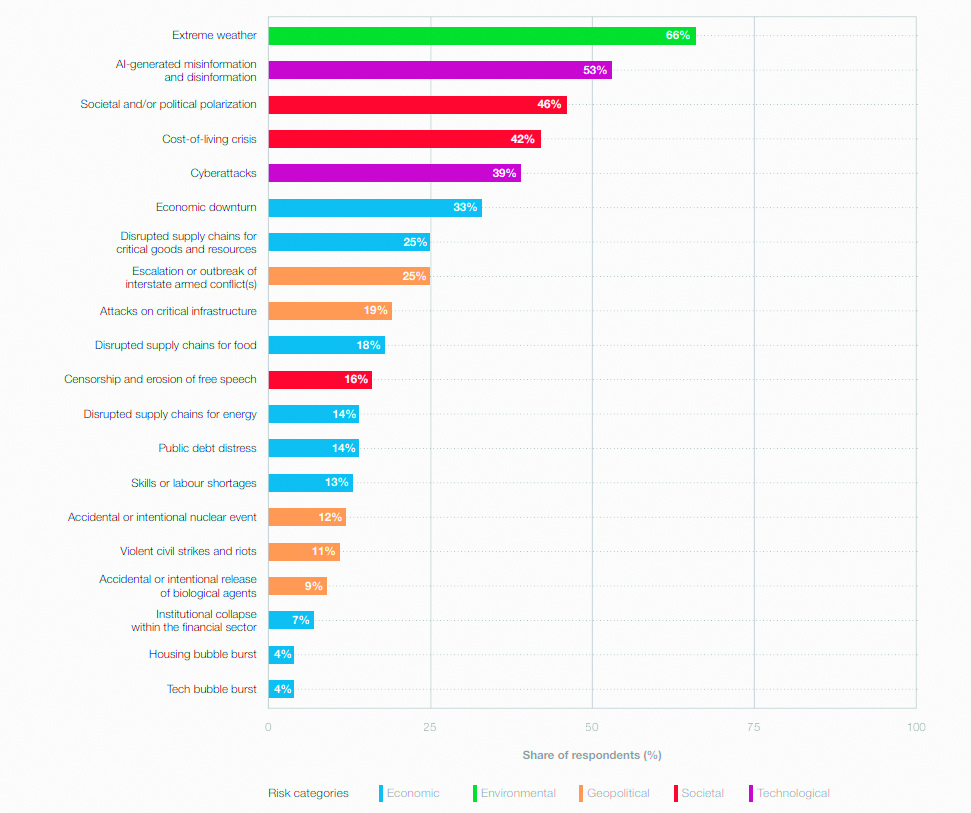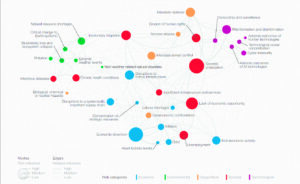
The World Economic Forum’s Global Risks Report 2024 identifies the most significant short-term risk as stemming from misinformation and disinformation, while in the long term, climate-related threats dominate the top 10 risks faced by global populations.
Key findings of the report underscore a world grappling with “a duo of dangerous crises: climate and conflict.” War, political polarization, an ongoing cost-of-living crisis, and the escalating impacts of climate change are destabilizing the global order, and posing intractable challenges.

The report, based on the Global Risks Perception Survey, gathers insights from nearly 1,500 global experts in academia, business, government, the international community, and civil society. Respondents express a lack of optimism, with 54% anticipating a significant degree of instability and a moderate risk of global catastrophes. Another 30% foresee worsening conditions, envisioning looming global catastrophes and a “stormy” or “turbulent” period ahead in the next two years.
In this year’s report, we contextualize our analysis through four structural forces that will shape the materialization and management of global risks over the next decade. These are longer-term shifts in the arrangement of and relationship between four systemic elements of the global landscape:
Climate change: Trajectories relating to global warming and related consequences to Earth systems.
Demographic bifurcation: Changes in the size, growth and structure of populations around the world.
Technological acceleration: Developmental pathways for frontier technologies.
Geostrategic shifts: Material evolution in the concentration and sources of geopolitical power.
A new set of global conditions is taking shape across each of these domains and these transitions will be characterized by uncertainty and volatility. As societies seek to adapt to these changing forces, their capacity to prepare for and respond to global risks will be affected.
Looking ahead 10 years, respondents become even more pessimistic, with almost two-thirds (63%) predicting a stormy or turbulent world order by 2034.
Environmental risks could hit the point of no return
Environmental risks continue to dominate the risk landscape over all three-time frames. Two-thirds of GRPS respondents rank Extreme weather as the top risk most likely to present a material crisis on a global scale in 2024, with the warming phase of the El Niño-Southern Oscillation (ENSO) cycle projected to intensify and persist until May this year. It is also seen as the second-most severe risk over the two-year time frame and similar to last year’s rankings, nearly all environmental risks feature among the top 10 over the longer term.
As polarization grows and technological risks remain unchecked, ‘truth’ will come under pressure
Societal polarisation features among the top three risks over both the current and two-year time horizons, ranking #9 over the longer term. In addition, Societal polarization and Economic downturn are seen as the most interconnected – and therefore influential – risks in the global risks network, as drivers and possible consequences of numerous risks.
Misinformation and disinformation further widen the socio-political divide
Emerging as the most severe global risk anticipated over the next two years, foreign and domestic actors alike will leverage Misinformation and disinformation to further widen societal and political divides (Chapter 1.3: False information).
As close to three billion people are expected to head to the electoral polls across several economies – including Bangladesh, India, Indonesia, Mexico, Pakistan, the United Kingdom and the United States – over the next two years, the widespread use of misinformation and disinformation, and tools to disseminate it, may undermine the legitimacy of newly elected governments. The resulting unrest could range from violent protests and hate crimes to civil confrontation and terrorism.
Inflation and economic crisis
The cost-of-living crisis remains a major concern in the outlook for 2024. The economic risks of Inflation and Economic downturn are also notable new entrants to the top 10 risk rankings over the two years. Although a “softer landing” appears to be prevailing for now, the near-term outlook remains highly uncertain.
There are multiple sources of continued supply-side price pressures looming over the next two years, from El Niño conditions to the potential escalation of live conflicts. And if interest rates remain relatively high for longer, small- and medium-sized enterprises and heavily indebted countries will be particularly exposed to debt distress.
GRPS results for 2024, 2026 and 2034 highlight current crises that corrode resilience, as well as new and rapidly evolving sources of risk that will reshape the next decade. For the one-year time frame, respondents were asked to select up to five risks that they feel are most likely to present a material crisis on a global scale in 2024.
After the hottest Northern Hemisphere summer in recorded history in 2023,2 two-thirds of respondents selected Extreme weather (66%) as the top risk faced in 2024. El Niño, or the warming phase of the alternating El Niño-Southern Oscillation (ENSO) cycle, is expected to strengthen and persist until May this year.3 This could continue to set new records in heat conditions, with extreme heatwaves, drought, wildfires and flooding anticipated.
AI-generated misinformation and disinformation (53%) and Societal and/or political polarization (46%) follow in second and third place. Many countries are still struggling to regain lost years of progress that arose from the COVID-19 pandemic, creating fertile ground for misinformation and disinformation to take hold and polarize communities, societies and countries.
Mirroring the previous year’s survey results, the Cost-of-living crisis (42%) and Cyberattacks (39%) remain major concerns in the outlook overall and appear as a top-three concern for government and private-sector respondents, respectively. The cost-of-living crisis is ranked higher by younger age groups: it was selected by 55% of respondents aged 39 or below, compared to just 28% of those aged 60 or over.4 Although energy and food crises ranked among the top risks of 2023, this year less than one-fifth of respondents selected Disrupted supply chains for food (18%) or Disrupted supply chains for energy (14%) as core concerns for 2024.
The survey was conducted in September of 2023, thus the outlook may have since shifted given the conflict in the Middle East, particularly if hostilities escalate. Climate pressures may yet drive prices higher;5 however, a warmer winter in the Northern Hemisphere, for example, followed by the easing of the El Niño cycle over the summer, could partially alleviate further energy price spikes resulting from any escalation of the Israel-Gaza or Russia-Ukraine conflicts.
Notably, while the survey was conducted before the outbreak of the former conflict, a quarter of respondents rank the Escalation or outbreak of interstate armed conflict(s) (25%) as among the top five risks for 2024, pointing to a broader set of concerns. With more than 200,000 deaths in 2022, conflict deaths are at the highest level in decades, driven predominantly by state-based armed conflict.6 Risks relating to the financial, tech and real-estate sectors are towards the bottom of respondents’ concerns for 2024.
In conclusion, in a 10-year context, climate-related risks contribute to five of the top 10 threats as the world approaches or crosses “climate tipping points.” Extreme weather events top the list, with nations unprepared for potential long-term and irreversible changes triggered by global warming.
While the threat of extreme weather is seen as immediate, there is disagreement about the urgency of other climate-related risks such as the loss of biodiversity and ecosystem collapse. Younger respondents express higher concern, raising fears that mitigation efforts could be delayed beyond a critical point.
With diminishing trust, political polarization, and a volatile geopolitical landscape, the potential for cooperation to tackle global risks is under pressure. The report suggests that solutions could emerge from more localized cooperation among nations, corporations, and individual citizens. However, given the scale of challenges, the report concludes that cross-border collaboration remains critical for decisive risks affecting human security and prosperity.
The 2024 World Economic Forum’s Annual Meeting in Davos, Switzerland, themed “Rebuilding Trust,” will focus on fostering open and constructive dialogue among leaders in government, business, and civil society to address these pressing global challenges.